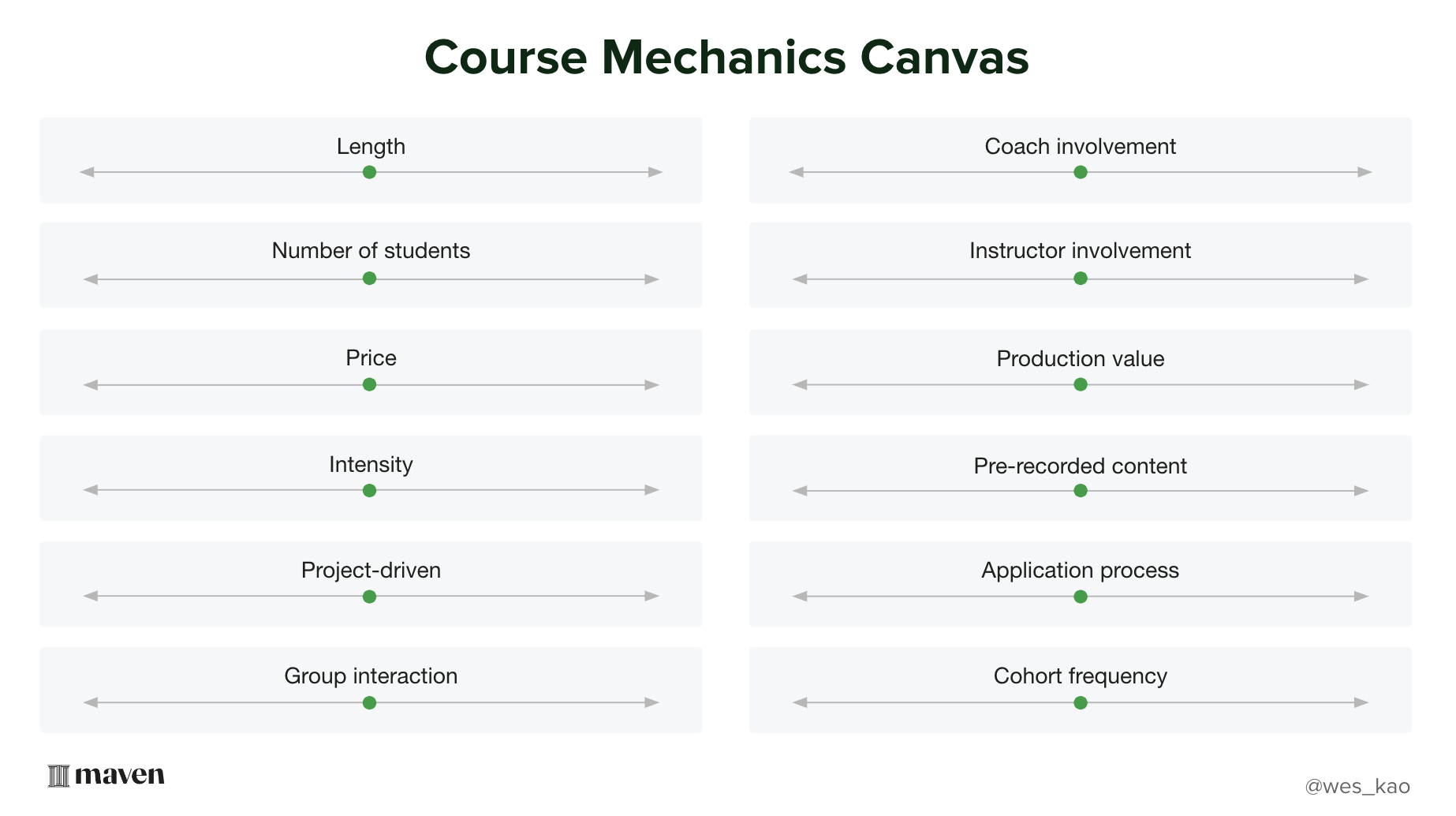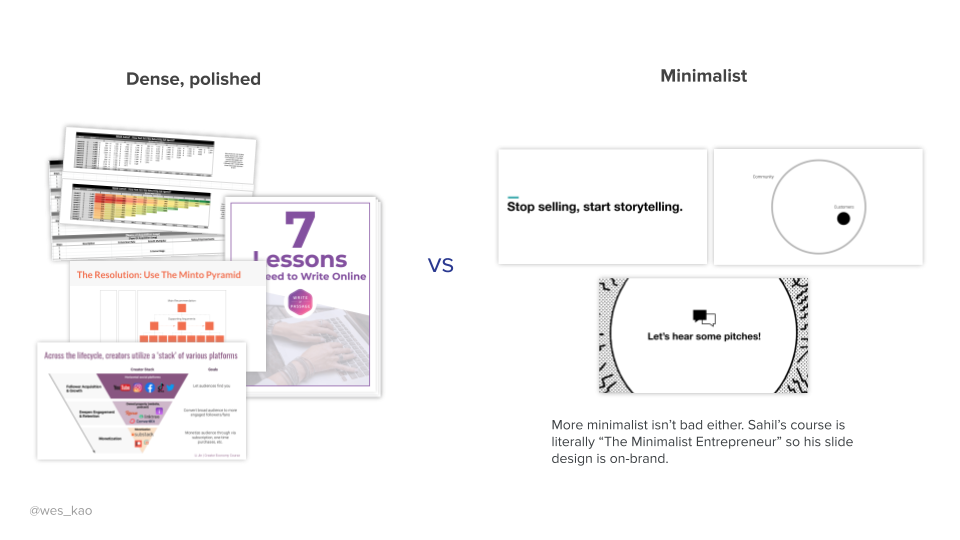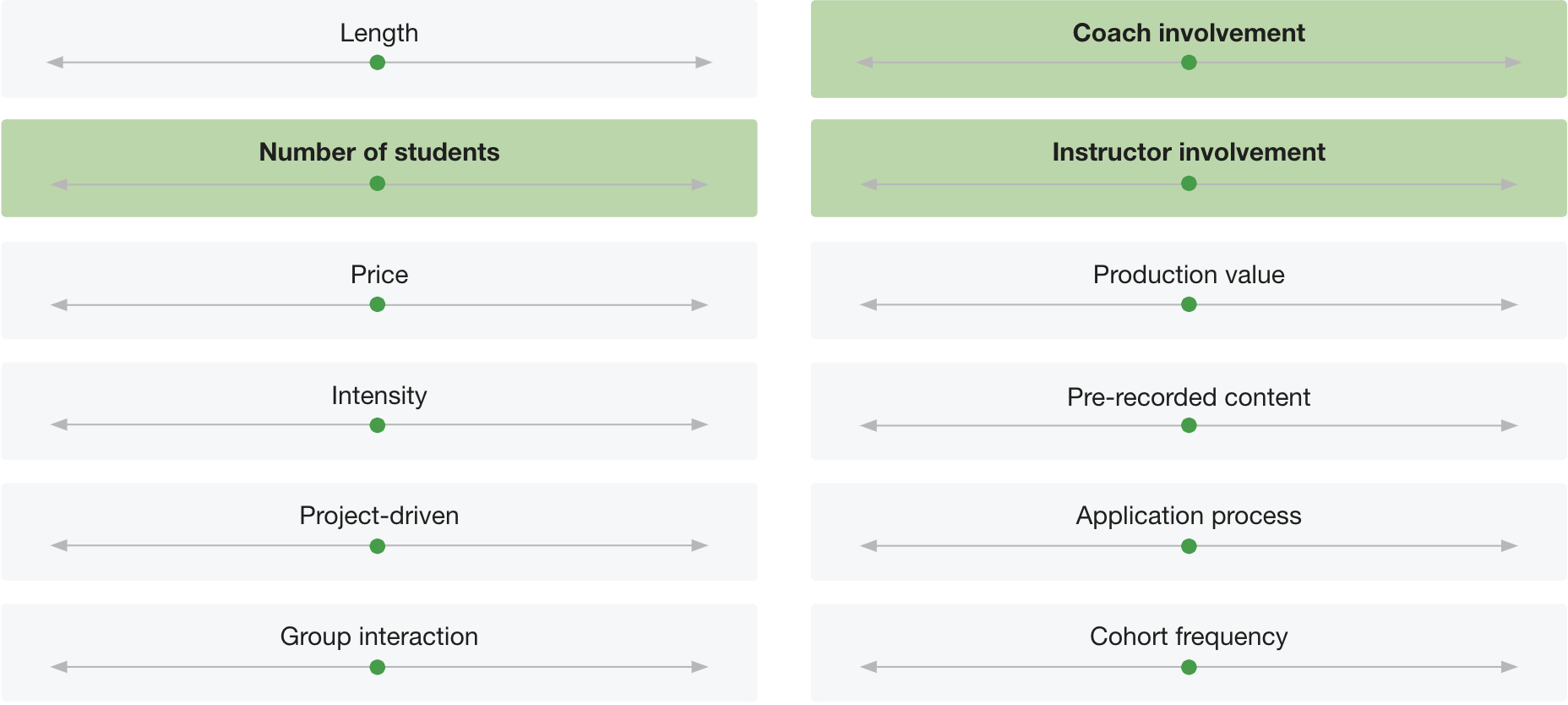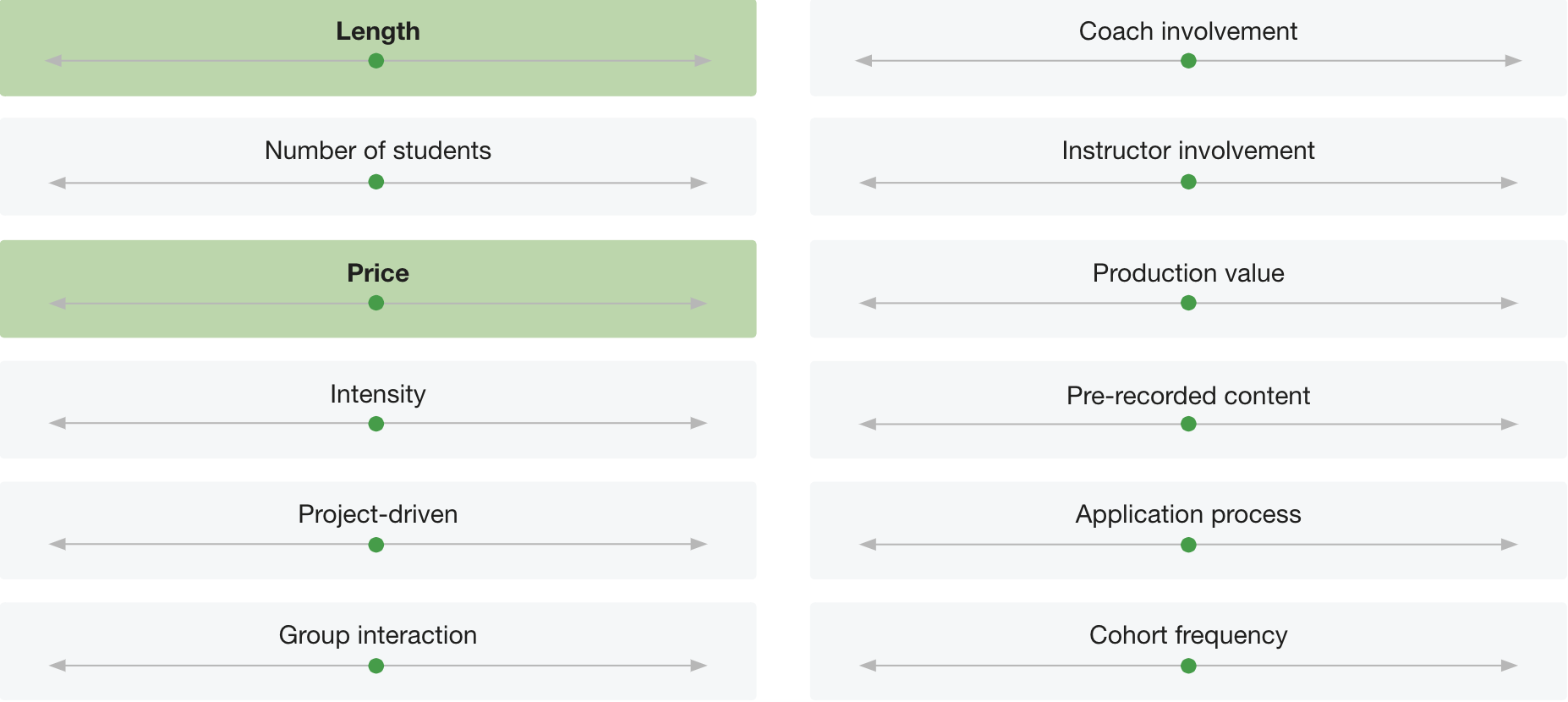This article was originally featured on Maven cofounder Wes Kao’s blog.New course creators are often overwhelmed by the variables, unknown unknowns, and amount of work involved in creating a complex digital product like a cohort-based course.
I talk to dozens of instructors a week and here are some questions I hear regularly:
How much should I charge for my course?
How long should my course be?
How many students should I aim for?
How much time and energy will I need to bring this to life?
What should my course’s weekly schedule look like?
One of the hardest parts about creating something new is the chicken-and-egg problem. The parameters influence the cost. The cost influences the parameters. And that’s just for two out of a dozen variables. All of these variables are part of an interdependent system: the decision along one axis will impact your options along the others. But where you do you start?
Enter the Course Mechanics Canvas. By using this framework, you’ll be able to make more confident decisions about your course pricing, length, student count, and more. Instead of guessing and shooting in the dark, you will have the language to discuss and shape your course around your unique circumstances and goals.
Before creating the Course Mechanics Canvas, I didn’t have an easy way to explain all the variables involved in creating a course while giving context about what other courses have done. Most new instructors simply wanted to copy other courses, but what works for other people won’t necessarily work for you. The Course Mechanics Canvas will help you abide by general principles while seeing what other courses do while creating something that’s uniquely yours.
If you’re a creator who wants to create a cohort-based course, but are overwhelmed by where to start, this post is for you. Let’s dive in.
Courses are a complex system with interconnected variables
A cohort-based course, like any product or business, is a system. Tackling each obstacle in isolation or in sequential steps won’t work. You need to apply parallel effort to the system as a whole, i.e. assert what to do for several different variables at the same time. This is hard because you don’t necessarily know how all the parts of the system should fit together, in what level of magnitude, in what way.
These are the same 12 levers I used with 1:1 consulting clients to design their courses from scratch, including directly working on building Section4, William Ury (Getting Past No/Getting to Yes), Morning Brew, and helping to level up Write of Passage, Ascend, and Build a Second Brain.

Here are the 12 levers:
Length
Number of students
Price
Intensity
Project-driven
Group interaction
Coach involvement
Instructor involvement
Production value
Pre-recorded content
Application process
Cohort frequency
The idea for the Course Mechanics Canvas framework was five years in the making. First, I had to identify the levers; second, see patterns about how levers were connected; then finally test these assumptions across multiple courses and cohorts. With this framework, you can avoid making the same mistakes I did along the way.
It might feel overwhelming to see 12 levers and have to pick for each. Luckily, it’s more intuitive than you think. Let’s dive into how to use these levers to shape your course and help you make key product decisions.
Part I: Start with student transformation
Two big questions:
What transformation do you want to create in your students?
What will help your ideal student achieve their outcome and transformation?
Whenever you get stuck, center yourself and refocus on these two questions. Set aside all your preconceived notions about what a course should be like, what you have to do, etc. Go back to basics and remember that your students are paying to be transformed. They want to learn a new skill, become a better version of themselves, get ahead in their work, or feel a sense of connection and inspiration in the air. Your course is simply a vehicle to help them get to where they want to go.
So think about where your student is now and where they want to go. The more “distance traveled” for student transformation, the more leverage you need. In the graphs below, x is where your student is now and y is where they want to be.
Big transformation: <-----x---------------y----->
Incremental transformation: <-------------x-----y----->
The greater the distance between x and y, the more transformation your course offers and the more value you provide—but the more leverage you need to help them achieve their goal. This can come in the form of levers like higher intensity, projects, coaching, instructor involvement, and more.
Let’s use a non-course example. Let’s say you’re a manager at a company. You have a new employee. They are fresh out of college, have never worked anywhere, and you need to get them up to speed to start producing work that’s high quality enough to replace a senior manager on your team. This requires a lot of leverage because you’re looking for a big transformation--you need leverage in the form of spending a lot of time personally coaching that person, having other team members train them, enrolling them in courses, and more.
Now imagine you have someone else who is already a senior manager at another company. To get that person on board, you don’t need to transform them as much. They need to learn the specifics of the role, but they’re ready to be valuable on week one.
If your student outcome is binary, you have a higher bar to reach. If your outcome is a spectrum, you have a lower bar. As long as your student improves a bit and moves to the right of the spectrum, they’re getting value from the course. You’ve set expectations sufficiently so any amount of improvement is seen as valuable. Of course, the bigger the improvement the more value the student will attribute to you.
✅ 🚫 Binary promise: Write your first script to send to TV producers
You either have the script complete or you don’t. If you want it to be high quality, the bar is even higher. If your student has never written a script, the distance between x and y is far. If your students are existing screenwriters, the distance between x and y is shorter.
📈 Spectrum promise: Improve your script writing, sharpen your craft, learn to edit
In this example, a script by the end isn’t guaranteed. If students improve their craft, they’re already getting the promise from the course. Any movement from x to the right towards y is good.
Here are more questions to ask about your ideal student that shape whether you should move to the right or left with each levers:
How much time does your ideal student want to commit? How many modules/topics do you need to deliver on your student outcome?
How much does your ideal student value intimacy, community, networking? (These aren’t mutually exclusive.)
How does the price reflect the juiciness of your value prop? What’s your ideal student’s willingness to pay? Does your course qualify for company reimbursements?
How long can your ideal student sustain a high level of intensity?
How important are projects for students to achieve their goal?
How does group interaction help your ideal student achieve their goal?
How much does a curated peer group impact the course experience? How would your students react to a perceived difficult application?
Pick your levers based on what will best serve your students and get them to where they want to go.
Part II: Identify assets and constraints
You are not starting from scratch. The world is not your oyster—this is a good thing.
Every course creator has different assets and constraints, which means you’re not starting from a blank slate. You’re not starting from scratch with these levers, so there aren’t as many choices available (or as much potential for analysis paralysis) as you might think. Some assets are available to you, and some aren’t practical choices for you. This is a very important point so I’ll repeat it. You are not starting from a blank slate when you’re creating your course. You literally don’t have access to some assets, while your fellow creators do—and vice versa. This narrows down your options for you.
Here are some questions to ask yourself to see what’s practical for your situation:
How big is your ideal cohort size? Do you like teams or prefer to do things solo end-to-end?
How involved do you want to be with each cohort? How open are you to hiring support?
How much do you enjoy interacting with students?
How good are you at slides, animations, video production, design? How open are you to spending money on this?
Have you created a MOOC already? How comfortable are you with producing articles and videos?
Do you have a full-time job? Is your CBC your main source of revenue or one of many products you offer?
Start with the lever(s) you care most about
So the first step is to take stock of who you are and your existing assets/constraints. This will allow you to see what strategies and tactics work for you, or don’t work for you, and help you plan what assets you want to gain over time. When working 1:1 with course creator clients, I always started with understanding their assets, constraints, and personal preferences. In other words, “What are we working with?” Don’t ignore your personal preferences. They are probably some of the reasons you’re excited about CBCs in the first place. You want to take these preferences into account so you can build a course that fits your lifestyle, your goals, your strengths, and the impact you want to make.
Start with the lever you care most about. It can be something you have a hunch about and a lever that makes you naturally more excited. Maybe it’s why you were drawn to a cohort-based course in the first place.
Begin with the lever that’s easiest to decide.
Right off the bat, some instructors already want to charge a certain price—either an accessible price point or a more premium one. Other creators care about scaling to hundreds of students per cohort, while others wanted an intimate number of students. Start with the lever where you have an intuitive preference or inclination.
These early choices serve as your anchors. You can always change these anchors, but do pick some. It might feel weird ‘locking yourself in’ but you’re not locking yourself in. You’re doing a thought experiment to scenario plan what your course would look like if you went down a certain path. You can (and should) play around with changing different levers to see how your course could look, then commit to building the version you feel most confident will work.
Once you decide the first lever, it impacts the others and you talk about the trade-offs. And you do this with the second lever, third lever, and so on. By the fourth or fifth lever, you’ll already start to see the other levers take shape given what you picked earlier.
Here are examples of assets that can work for your course:
Great at your craft
Audience on Twitter
Email list of engaged subscribers
Strong relationships
Great reputation in your industry
Existing body of work that shows your thinking
Paying clients who see value in your work
Content you’ve already built
Frameworks and ideas that add value
Charismatic personality
Teaching ability (ability to distill complex topics into approachable ideas)
Willingness to work hard
Spiky points of view about your topic
Business, marketing, product sense
Money to invest in your course
Time to invest in your course
Great speaking voice and public speaking ability
You might have noticed that many items on this list aren’t things you can do overnight. This is both bad news and good news. It’s bad news because if you want to do it overnight, it will be hard to. The good news is, you probably already have at least a few of these assets available, and these are a moat. A random person who wanted to create a course couldn’t just do it because they haven’t spent years honing your craft like you have.
You have access to some of the levers above, but not others. Like most things, trying to do anything fast or taking shortcuts usually isn’t ideal.
For example, take Person A and Person B:
🚫 Person A: An operator who is mediocre at their craft, hasn’t written anything online, doesn’t have many relationships—and now wants to teach a course.
✅ Person B: An operator who has built a reputation for doing great work in their industry, has been building their email list, and has sharpened their skills—and now wants to teach a course.
Both people want to create a course. It will be easier for Person B to charge more for their course or fill seats. Not because they are inherently better, but because they’ve spent more time building their personal credibility and assets.
One more note: Filling your course isn’t only about audience size. It’s tempting to say, “I don’t have a big audience so I can’t teach.”
You don’t need a big audience. You need a distribution channel to reach your target students, credibility with your audience, and a juicy value proposition worth paying for. Audience size is sometimes a proxy—but only because the creator has spent years adding value to their audience (usually for free) and their audience trusts them. It’s lazy thinking to point to a creator with 50k followers and say “Well it’s easy for them to teach.” Actually, they just started the process years before you did.
Build your course around your circumstances
Three questions to ask yourself:
What are your assets and constraints? We discussed this above.
What are your strengths, weaknesses, and natural inclinations?
What’s practical for your situation right now?
These three questions about your PERSONAL SITUATION will narrow down a lot of the variables. For example, how good are you at creating slides, animations, video production, design? How open are you to spending money on this? If you have good design sense, are scrappy and resourceful, and/or have experience creating clips in iMovie and already have a good camera set up, then production value can be a differentiator.

Part III: First principles and analogies
When building your course, you want to consider both first principles and analogies to maximize your ability to make good decisions.
First principles allow you to get creative with your course while abiding by core truths. The levers give you shared language, so you’ll have more productive conversations and avoid anxiety from wondering if you’re forgetting an important element.
Everyone talks about the benefits of first principles, but there’s a reason it’s not most people’s first instinct to actually use first principles: Because it’s hard. When you don’t know much about a new field, the easiest and “safest” thing to do is mimic other people, i.e. learn by analogy. “What does so-and-so do for their course? Okay, I’ll just do that with some slight tweaks.”
When you’re learning something new, you can’t step outside the box because you don’t even know where the box is. Learning by analogy is useful because you can get a lay of the land to see what’s been done before. That’s why for each lever, I mapped where popular CBCs are on each spectrum so you have a bird’s eye view of what works for other courses. (This is at the bottom of the post.) Then, over time, you’ll borrow from multiple sources, recombine, enhance. You’ll be able to develop your point of view on what you want your course to be.
Now onto some common groupings of levers. These tend to “move” in a bundle and have second order consequences within the system of your course.
Grouping 1: Intensity, Project-driven, Group Interaction
Courses promising high transformation tend to be higher in intensity, projects, and group work.
The intensity matters because, like many things, it’s either a bug or a feature. Some students like working out until they puke and having a drill sergeant scream at them. Other students like exercising at a more doable pace.
The altMBA is an intense course requiring about 15-20 hours/week of commitment. The back-and-forth feedback among peers and real-time group projects are a core part of the course experience so students must attend the mandatory group working sessions 3 times per week. This can turn off a lot of people because they don’t want to work to the point of exhaustion in a course they’re doing in their free time. But it also attracts a bunch of people who are excited that there is finally a course that will push them to the brink.
Low intensity courses can be just as transformative. AliveOS is low intensity from a time and bandwidth perspective, but students gain a lot from vulnerable group discussions and reflective weekly homework that takes about 30 minutes to complete. Another example of a low intensity course is On Deck Fellowship, where the value comes from the network.
The topic matters for intensity—with AliveOS, a lot of the value was from group discussion and talking about your ideas out loud. If the altMBA took this approach, it likely wouldn’t be as effective because a lot of the value from the altMBA was driven from publishing and shipping work.
You might not have the ability to create many course assets like project prompts, slide decks to accompany your lectures, or homework assignments—either due to bandwidth or because it's not your style. In that case, avoid choosing a project-heavy and intense course. You might still want to consider adding interactivity though because...
Projects and group discussions contribute to a sense of community and active learning, both of which are scarce compared to free or low-cost resources. With YouTube, articles, video courses, etc, most of the work is solo and it’s about content consumption. If that’s all you offer, why should students pay for your course? They might as well take a $25 video course or better yet, read some free articles. “Projects” don’t only include intense assignments. It can include shorter exercises, breakouts in Zoom, group discussion prompts, reflection questions to ping into Slack, and other forms of interactivity—all increase hard-to-replicate value which increases your student’s willingness to pay.

Grouping 2: Number of students, coach involvement, instructor involvement
Design your course for your eventual number of students. Why? The dynamic is entirely different when you have a small group of 10-15 students. The instructor’s charisma and attention are enough to tide students over and fill in gaps, whereas it won’t be sufficient when you have 50+ students vying for your attention.
The altMBA had 100–120 students per cohort with concurrent cohorts running at the same time. Each cohort was its own little bubble of 120 students. So you’d have altMBA 10 and altMBA11 cohorts running separately but simultaneously. This allowed us to keep the same logistical amount of prep work the same, but still grow student count. Creating sub-cohorts like this is common. If you have 1,000 students like Build a Second Brain or Section4’s sprints, you could benefit from breaking folks into smaller sub-cohorts to help create a sense of intimacy and help the course from feeling overwhelming.
You can start small and grow consistently. For example, Shivani Berry’s Ascend leadership program for women started with 10-15 students in the first cohort. Her second cohort had 25 students. Her third had 50 students. And her current cohort has about 100 students.
Once you reach over 50 students, coaches are a powerful layer to add leverage. Coaches offer support so the instructor doesn’t have to be everything to everyone, or be at 10 places at once. How many coaches should you have? The altMBA had a coach ratio of 1:10. Section4 has a coach ratio of 1:100. Many courses are somewhere in between. A high or low ratio isn’t necessarily good or bad—it depends on the course’s promise and whether students are getting their needs met.
Across courses, the coach role varies a lot. Sometimes coaches need to be subject matter experts to give feedback to students. In other courses, like altMBA and AliveOS, coaches don’t need specific subject matter expertise to support students. Some coach responsibilities are 2–3 hours a week where they hold one live group session. Other courses have coaches who work 15–20 hours/week because responsibilities include reviewing and giving detailed feedback on student work.
In general, the lower your instructor involvement, the higher your coach involvement. If you promise high transformation, then the more students you have, the more coaches you'll need. In the altMBA, Seth didn’t want to be involved in the day-to-day or need to show up for the course, so we had lots of passionate, trained coaches who we recruited from our alumni community to guide students.
In many beloved cohort-based courses, students interact more with each other and with coaches than they do with the instructor. You as an instructor don’t want to be trapped in a low leverage position where your course doesn’t work unless you’re personally involved in each aspect. It’s actually harder to design a course that lets students get more value from working with peers/coaches than they do with you, but it’s worth it.

Grouping 3: Length and price
Making a course longer is an easy, low-hanging fruit way to make the price feel more justifiable, but that’s not necessarily a good thing. Avoid making your course longer because you feel like it’s the only way your students will pay. If you truly think your course should be a certain length, frame the message so you can explain your rationale to your target student so they see the benefit of the course length you picked.
Some students think, “If I’m paying this much, I want the course to last longer to get my money’s worth.” The worldview is that longer courses are more valuable. This thinking is rooted in in-person events, where an instructor could only be in one place at one time (scarcity), so by that logic, if a course runs for longer, they have more exposure and the experience lasts longer. They might do the ‘cost per wear’ calculation that folks in the fashion industry use, and divide the price by the number of days/weeks.
For example, charging $1,000 for a one day course might feel expensive. But charging $1,000 for a 3 week course suddenly feels more reasonable. This isn’t to say you can’t charge $1,000 for a one day course. There are some consultants who already charge that or more for in-person workshops, so it’s definitely possible to charge that for a CBC given the value you’re adding and how painful the problem is that you’re solving. If you’re solving a painful, expensive problem, then you can charge more and students are still eager to buy.
On the other hand, a different type of student thinks, “I’d rather pay more to get to my goal faster.” If that’s the worldview of the student you’re targeting, then you want to play up how much time they’re saving by learning the topic quickly so they can get on with their lives.
From a pricing psychology perspective, there’s a subconscious line with below $1,000 and over $1,000. It’s the difference between three vs four figures. Length-wise, courses range from 1 day to 10 week coding bootcamps. Many cohort-based courses today are 2-4 weeks or 6-8 weeks.

Part V: Unpacking the course levers
There are lots of cohort-based courses—and more popping up each day. Feel free to use my Course Mechanics Canvas to plot and dissect your favorite courses to see more clearly how they’re set up under the hood. I’ve jotted notes on the pros/cons and trade-offs on each lever below.
1. Length
Shorter
Pros: Easier to commit; can have more frequent cohorts
Cons: Less opportunity to build relationships and community
Longer
Pros: More opportunity for depth
Cons: Might be harder for students to commit and stay motivated
2. Number of students
Few
Pros: More intimate, more personalized, and higher perceived value.
Cons: Smaller community/fewer alumni out in the world, less revenue, fewer potential promoters
Many
Pros: Community building and networking, more revenue, more potential promoters
Cons: May not offer as intimate of an experience for students
3. Price
Less expensive
Pros: Accessible to a wider audience
Cons: May be perceived as lower value; less differentiated from MOOCs
More expensive
Pros: More resources to invest in the course experience, including higher coach:student ratio, opportunity for smaller groups; prestige; cognitive dissonance
Cons: Price will filter out students, which is both good and bad
4. Application process
Light application
Pros: Lightweight so less friction; widens audience; possibly more applicationsCons: Less control over audience; some students who apply may not actually be a good fit
Expect to be rejected
Pros: Gives you more customer development info to build your course; curated like-minded students; prestige; more committed students
Cons: Narrows audience because some folks dislike being rejected
5. Production value
Low
Pros: Feels personal and authentic
Cons: Low production value can be distracting for otherwise great content/ideas
High
Pros: Perception of quality, could be differentiator competitors don’t have or aren’t willing to do
Cons: Production costs = time and money
6. Coach involvement
No coaches
Pros: Simpler because no need to recruit/train/manage coaches, higher margins
Cons: A lot more work for instructors to give feedback, answer questions, moderate workshops themselves, and provide support to all students themselves
High
Pros: Intimate student experience at scale; takes onus off instructors to give feedback; staff oversight to make sure students on track
Cons: Need to recruit, train, manage coaches; lower margin
7. Instructor involvement
Low
Pros: Highly leveraged for the instructor
Cons: Can be harder to pull off and explain value
High
Pros: Full control over course experience
Cons: Takes more time
8. Group interaction
None
Pros: Focus on high quality lecture content
Cons: Bonds between students might be less deep
A lot
Pros: Engaging for students; students learn just as much from peers; builds community and lifelong friendships
Cons: Logistics; more variables because people are unpredictable; hard to write great prompts and design group dynamics
9. Project-driven
Few to no projects
Pros: Focus more on content quality versus student accountability
Cons: Students may feel like they didn’t create anything or get enough out of the course
Lots of Projects
Pros: Students have a chance to put what they’re learning into practice, which results in better student outcomes; more artifacts/proof of value from doing the course
Cons: Difficult to control how students execute work; heavier lift for instructor to create meaningful projects; increased coach/TA workload to give feedback
10. Intensity
Low
Pros: More accessible to people allocating a few hours a week
Cons: Potentially lower actual & perceived value due to fewer opportunities to influence and transform your students
High
Pros: More actual and perceived value due to students doing the work. Students form deeper bonds.
Cons: Students might not be able to commit to the time
and energy required to do your course
11. Pre-recorded (amount of)
A little
Pros: Live workshops feel more intimate and valuable
Cons: Difficult to scale, quality might vary from one session or cohort to another
A lot
Pros: More scalability
Cons: Students might think it’s too close to a MOOC (“Why should I pay a premium if it’s just pre-recorded content?”), can’t easily pivot content because need to re-record
12. Cohort frequency
Low
Pros: More operational leverage and efficiency
Cons: Fewer chances for students to sign up each year
High
Pros: More dates/times for students to join
Cons: Operational overhead and logistics to scale
Types of cohort-based courses
To help you put the levers into context even more, here are general types of courses I’ve seen recently as the category of CBCs is growing. The types below are not comprehensive. This is to help get you started in thinking about some types of courses to inspire your starting point. From there, you can adjust so it works for you.
Intense courses. A course can be intense in different ways, but usually it’s because there’s a high “distance traveled” with student transformation. So it might require lots of time investment per week due to projects, real-time meetings, or mandatory deliverables. Examples include the altMBA, Maven’s How to Build a Cohort-based Course, and Lambda School.
Levers: Intense courses could have more projects, more group interaction, and a more rigorous application process to select for students who are ready to do the work. You can have intense courses that are both short or long—it’s more about the density and the distance traveled for student transformation.
Networking courses. This is an unstructured, choose-your-own adventure style with lots of guest speakers. The best example is On Deck. Almost all cohort-based courses have varying levels of community as a value prop, but the majority of the value of networking-driven courses is in the people you meet. So curating a thoughtful class of like-minded people becomes especially important for this type of course.
Levers: Networking courses could be less intense, fewer projects, fewer coaches, and low instructor involvement, and have a more rigorous application process to curate an interesting cohort.
Experiential courses. Suzy Batiz, the CEO of Poo~Pourri and creator of the AliveOS course, has zero slide decks in her 8-week course… But it’s one of my favorite CBCs and she’s selling at ~$2k/student. Her weekly homework assignments are simple Google Forms (no projects, no breakouts, no group exercises) and her weekly discussion groups are very unstructured (no coach feedback). Her course still leads to lasting behavior change and transformation for students.
Levers: Experiential courses could have fewer written projects and lectures—it’s more about carving out time to reflect solo or in real-time with your classmates. It’s more about a place where you feel seen and heard, and come to your own breakthroughs, and less about producing work output.
Accountability and motivation courses. This is the "I've been meaning to do this for a while and want to pay someone to make me do the thing" course. The analogy is hiring a personal trainer or joining a group fitness class to make sure you show up at the gym. This type of course usually has one or two live workshops where the expert instructor lectures with plenty of interactivity and breakouts for students to practice what they learn. Plus homework and small group discussions led by coaches.
Levers: Accountability and motivation courses range all over with each lever. They usually have higher instructor involvement during the weeks when the course is live because students are fans of the instructor. The instructor involvement usually comes in the form of live workshops 1-2x per week. Most Maven courses so far are in this bucket, including Lenny, Li, Pomp, and Sahil’s courses.
Short courses. Nas Academy has 1 day courses that are a blend of recorded videos and live community for $29. Hyperlink has a price point in the $200 range. For students, these courses are more affordable and can be an impulse purchase. For instructors, shorter courses are easier to create and require less content. Many CBCs are a few to several weeks, so I wanted to include short courses to encourage you to consider courses that are only one day or a few days long.
Levers: Short courses are low on length, might be lower on price but not necessarily.
The category is changing so fast and more courses are popping up by the day, so consider this a starting point and keep your eyes peeled for courses that fall into and outside these buckets.
Put this into action for your course with a rubber band exercise
You know how when you pull a rubber band, it stretches a ton but eventually pops back—but the stretch gets a bit looser? I call this type of thought experiment a rubber band exercise.
The goal is to force you out of your comfort zone to stretch you to try options you otherwise wouldn’t try yourself—which spurs new insights and breakthroughs. Even if your only insight is learning what you don’t like, that still helps you feel more confident about what you do want to do. And many times, what you’ll discover is that the new options are more appealing than you thought.
Imagine your course as:
Determine how these levers influence your value prop, learning outcomes, and ideal student.
There are many ways to teach your topic. In the
Maven Course Accelerator, I taught the same material as an alpha test over the duration of 5 days. Then taught it in a 6-week course. Now, it's a 3-week course. Once you understand the main components, you can expand or contract different parts to shape your course. My philosophy of course building is to
build courses that are modular. This is a fun and powerful skill, and it’s totally doable once you’ve built the core components.
---
Ready to get started? Over 3,000 subject matter experts have gone through the Maven Course Accelerator to turn their knowledge into a community-driven, live course. Sign up for a free account on Maven to
join our next cohort.
When you start earning on Maven, you keep 90% of your course revenue minus Stripe fees. On average, instructors earn $20,000 in their first cohort. Plus, you own your IP and content. Our goal is to help you launch and grow a course you’re proud of.






